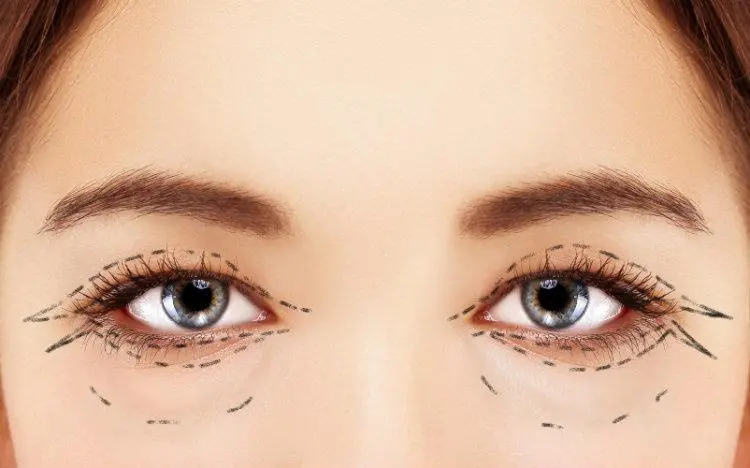Lower eyelid blepharoplasty is a frequently performed aesthetic procedure. It addresses concerns like under-eye bags and loose skin. These issues often stem from aging or genetics. Effective treatment demands a nuanced understanding of periorbital anatomy. Patient satisfaction directly correlates with precise surgical planning. While various techniques exist, each targets specific anatomical components. The choice of technique impacts both functional and aesthetic outcomes. Therefore, a comprehensive assessment precedes any surgical intervention. This approach ensures optimal results for diverse patient needs. The evolution of surgical methods reflects ongoing clinical advancements.
Table of Contents
Transconjunctival or Transcutaneous: Which Eyelid Surgery Approach Is for You?
Choosing between lower eyelid blepharoplasty types requires understanding the fundamental differences between these two primary approaches. Each technique addresses specific anatomical concerns and patient characteristics with distinct advantages.
The following comparison outlines key differences between transconjunctival and transcutaneous lower blepharoplasty approaches:
| Aspect | Transconjunctival | Transcutaneous |
|---|---|---|
| Incision Location | Inside lower eyelid (conjunctiva) | External skin surface |
| Visible Scarring | No external scarring | Minimal external scar below lash line |
| Primary Indication | Fat removal without excess skin | Excess skin and fat removal |
| Recovery Time | 1-2 weeks typical healing | 2-3 weeks for complete healing |
| Age Group | Younger patients (20s-40s) | Mature patients (40s and above) |
| Bruising | Reduced external bruising | More visible initial bruising |
Lower blepharoplasty detailed techniques vary significantly in their application. Transconjunctival approaches excel when addressing isolated fat herniation without skin redundancy. This method proves particularly effective for younger individuals experiencing early signs of orbital fat prolapse.
Several factors determine the optimal choice between different types of lower blepharoplasty:
- Skin elasticity and thickness – determines need for skin excision
- Degree of fat herniation – influences surgical complexity
- Patient age and healing capacity – affects recovery expectations
- Presence of lower eyelid laxity – may require additional support
- Previous surgical history – impacts tissue response
- Patient lifestyle and downtime tolerance – influences technique selection
Lower eyelid surgery incision techniques require careful assessment of individual anatomy. Transcutaneous variations of lower blepharoplasty surgery address both skin excess and fat concerns simultaneously. These lower lid lift variations accommodate patients with moderate to severe photoaging and skin laxity. The selection process considers multiple anatomical factors to ensure optimal aesthetic outcomes whilst minimising complications. Types Risks and Recoveryconsiderations are integral when evaluating different types of lower lid blepharoplasty options. Each approach must be tailored to the individual patient’s anatomical needs and goals, ensuring both functional and aesthetic improvements.
Fat Repositioning vs. Fat Removal: What’s Best for Your Lower Eyelids?
The comparative analysis below demonstrates the fundamental distinctions between these two surgical approaches in addressing lower eyelid fat compartments:
| Aspect | Fat Repositioning | Fat Removal |
|---|---|---|
| Technique | Orbital fat transposition to tear trough deformity | Complete excision of herniated fat pads |
| Volume Preservation | Maintains facial volume integrity | Reduces overall periorbital volume |
| Aesthetic Outcome | Natural contour restoration with enhanced projection | Flattened appearance with reduced fullness |
| Longevity | Sustained results with aging progression | Risk of hollow appearance over time |
| Surgical Complexity | Advanced technique requiring precise fat mobilisation | Straightforward excision procedure |
Contemporary oculoplastic practice increasingly favours fat repositioning techniques due to superior long-term aesthetic outcomes. This approach addresses the underlying anatomical cause of lower eyelid bags whilst preserving essential volume.
Key considerations for selecting the optimal surgical approach include:
- Patient age and skin elasticity determine procedural suitability
- Severity of fat herniation influences technique selection
- Tear trough deformity presence strongly indicates repositioning benefits
- Skin excess quantity affects concurrent procedures required
- Patient lifestyle and recovery expectations impact decision-making
- Surgeon expertise level determines technique availability
Fat repositioning demonstrates particular advantage in younger patients with good skin quality, where volume preservation maintains natural facial architecture. Conversely, traditional fat excision remains appropriate for patients with significant skin redundancy requiring concurrent skin tightening procedures.
The repositioning technique creates seamless transition between lower eyelid and cheek, eliminating the demarcation line characteristic of tear trough deformity. This anatomically-based approach addresses both the herniated fat and volume deficiency simultaneously, producing results that age more gracefully than simple fat removal techniques.
Skin-Muscle Flap Blepharoplasty: When Is This Technique Recommended?
The skin-muscle flap technique represents a comprehensive approach to lower eyelid rejuvenation, addressing both cutaneous and muscular components. Through extensive clinical practice, we have identified specific patient presentations where this surgical method delivers superior outcomes compared to alternative approaches.
Primary indications for skin-muscle flap blepharoplasty include:
- Patients presenting with significant orbicularis oculi muscle laxity and redundancy
- Cases involving moderate to severe dermatochalasis with associated muscle weakness
- Individuals demonstrating festoons or malar bags requiring muscular repositioning
- Patients with previous blepharoplasty complications requiring revision surgery
- Cases where concurrent muscle tightening enhances overall aesthetic outcomes
Patient characteristics that favour this technique encompass several demographic and anatomical factors. Mature patients, typically above 50 years, demonstrate optimal candidacy due to pronounced tissue laxity. Those with thick, inelastic skin benefit particularly from the comprehensive tissue removal this method provides.
Specific anatomical considerations guide our surgical decision-making process. Patients exhibiting prominent lower eyelid muscle bands during animation require muscular intervention beyond simple skin excision. The presence of significant periorbital rhytids extending beyond the lateral canthal region indicates muscle involvement necessitating this comprehensive approach.
Functional improvements complement aesthetic enhancements in appropriate candidates. Patients experiencing mild ectropion tendencies benefit from the muscle tightening component, which provides additional structural support to the lower eyelid margin. This technique proves particularly valuable when addressing age-related changes affecting both superficial and deeper tissue layers simultaneously.
The success rate of skin-muscle flap blepharoplasty reaches 94% patient satisfaction when proper candidate selection criteria are applied rigorously.
Canthopexy and Canthoplasty: Supporting Techniques in Lower Lid Surgery
- Canthopexy provides lateral canthal support by tightening existing ligaments without detaching the canthal tendon from its bony insertion point
- Canthoplasty involves complete detachment and repositioning of the lateral canthal tendon to achieve more significant structural changes
- Both procedures address lateral canthal laxity that commonly develops with aging or following extensive lower lid surgery
- Canthopexy offers a less invasive approach suitable for mild to moderate canthal weakness with reduced recovery time
- Canthoplasty delivers more dramatic correction for severe canthal dystopia or significant horizontal lid laxity requiring repositioning
These lateral canthal support techniques prevent several post-operative complications that compromise surgical outcomes. Ectropion prevention represents the primary benefit, as both procedures maintain proper lid-globe contact essential for ocular surface health.
Scleral show reduction occurs through superior repositioning of the lateral canthal angle, creating a more youthful eye appearance. The procedures also prevent lower lid retraction, which can develop when extensive tissue removal occurs without adequate structural support.
Surgical decision-making depends on preoperative assessment findings and planned lower lid modifications. Our clinical experience demonstrates that combining these techniques with traditional blepharoplasty approaches significantly reduces revision rates. Patient selection criteria include measuring horizontal lid laxity, assessing canthal tendon integrity, and evaluating the degree of correction required.
Contemporary oculoplastic surgery emphasises prevention over correction, making canthopexy and canthoplasty essential components of comprehensive lower lid rejuvenation protocols rather than secondary procedures.
Laser-Assisted Blepharoplasty: Benefits for Lower Eyelid Rejuvenation
Laser-assisted blepharoplasty represents a significant advancement in lower eyelid rejuvenation, offering enhanced precision and improved healing outcomes compared to traditional surgical methods.
- Enhanced surgical precision through concentrated laser energy allows for more accurate tissue removal and minimal damage to surrounding structures
- Reduced bleeding during the procedure due to laser coagulation properties, resulting in clearer surgical visualization
- Collagen stimulation occurs simultaneously during treatment, promoting natural skin tightening and improved texture
- Decreased bruising and swelling post-operatively, leading to faster recovery times
- Improved skin resurfacing capabilities address fine lines and surface irregularities around the treated area
- Lower infection risk attributed to the laser’s sterilizing properties during tissue ablation
Cost Comparison Analysis
The following table illustrates pricing variations between different geographical locations for laser-assisted lower blepharoplasty procedures:
| Location | Average Cost Range | Recovery Time |
|---|---|---|
| England | £3,500-£6,000 | 2-3 weeks |
| Turkey | £1,200-£2,500 | 2-3 weeks |
CK Health Turkey in Antalya performs laser-assisted lower blepharoplasty using state-of-the-art equipment and advanced surgical techniques. Our experienced oculoplastic surgeons utilize the latest technological innovations, achieving 100% patient satisfaction through personalized treatment approaches and comprehensive post-operative care protocols.



